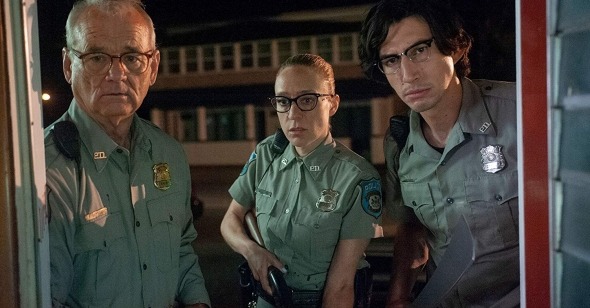The Inevitable
By Jordan Cronk
The Dead Don’t Die
Dir. Jim Jarmusch, U.S., Focus Features
It’s perhaps inevitable that Jim Jarmusch, having spent much of his career applying postmodernist touches to all manner of genres, would one day arrive at the zombie film. That it comes in 2019, years past the waning days of the genre’s post-millennial renaissance, is but one of the many idiosyncratic features of The Dead Don’t Die, the director’s thirteenth narrative feature. At a glance a strangely passé move for an artist once considered to be at least one step ahead of the zeitgeist, the movie’s unfashionably late arrival is, at the same time, in keeping with such proudly off-trend genre experiments as Ghost Dog (1999) and Only Lovers Left Alive (2013), two key precursors to Jarmusch’s existential take on the zombie film.
An uncanny, out-of-time aura permeates The Dead Don’t Die, a feeling established in the film’s opening moments as police officers Cliff Robertson (Bill Murray) and Ronnie Peterson (Adam Driver) drive through the fictional town of Centerville following an ominous chat in the woods with local eccentric Hermit Bob (Tom Waits). Something strange is afoot: it’s oddly light out for being nighttime, while Ronnie’s watch and cellphone have stopped working. Back at the station, junior officer Mindy Morrison (Chloë Sevigny) watches over the corpse of the town drunk, which may not be as close to rigor mortis as once thought. Turns out, “polar fracking” has shifted the earth’s axis, awakening the dead, media reports of which have the locals on edge. Among this rogues’ gallery is farmer and token white nationalist Frank Miller (Steven Buscemi); auto mechanic Hank Thompson (Danny Glover); gas station clerk Bobby Wiggins (Caleb Landry Jones); and a sword-wielding undertaker named Zelda Winston (Tilda Swinton). Meanwhile, in intersecting story threads, a trio of juveniles plot their escape from the town’s local detention center, and a young girl (Selena Gomez) and her two friends arrive from the big city looking for a hotel for the evening.
Despite the range of personalities, the film is ultimately stronger in theme and style than character, more substantial in its diagnosis of human folly than its detached depiction of small-town life. Many of the townsfolk are caricatures, though in most cases they’re imbued with enough organic Jarmuschian flavor to land just this side of shtick; others, such as Swinton’s mortician-cum-martial-arts-maven, feel like parodies of past creations or roles reverse engineered for specific actors. Employing his signature deadpan affect in service of a kind of suspended anxiety, Jarmusch allows the film’s droll humor to be swallowed in a vacuum of inertia, as if the fate of the world has been foretold and the characters are helpless to reverse what they’ve started—a sense heightened by cinematographer Frederick Elmes’s eerily tranquil, elevated tracking shots and churning drone-rock compositions by Jarmusch’s band Sqürl.
The soul of the film lies with Murray, Driver, and Sevigny, who generate a touching dynamic and thoughtful repartee between their characters while expressing a genuine sense of collective fear and emotional distress as the town is slowly overtaken by outside forces. (Though Jarmusch claimed in a recent interview with Film Comment that his “heart is always with teenagers,” there’s a clear and perhaps revealing affection for the cops in this film.) Their individual reactions to the uprising––Cliff with a kind of becalmed resignation, Ronnie with fight-or-flight survival instinct, and Mindy with full-bodied terror––prompt the kind of moral questions one has come to expect of a modern zombie film, but here, filtered through the same existential worldview that’s fueled such otherwise contrasting Jarmusch protagonists as Ghost Dog and William Blake (from the director’s 1995 western Dead Man), these inquiries take on a kind of cosmic grandeur not often associated with the genre, exemplified by a closing soliloquy by Hermit Bob that finds a certain poetry in mankind’s annihilation.
This being a Jarmusch film, the zombies, all mottled flesh and bloodied hair, are played by a combination of aging rock stars (Iggy Pop), filmmakers (Sara Driver), models (Charlotte Kemp Muhl), and musicians (Sturgill Simpson, who also provides the film’s delightfully macabre title theme), and together stand as a simultaneous product of the audience’s collective unconscious and a symptom of the characters’ environmental neglect and blind consumerism. If thematically we’re not far from George A. Romero’s trailblazing zombie films, Jarmusch updates the scenario in a way that makes the inevitability of disaster feel all the more personal, even tragic. As farmer Frank’s red hat and racist rhetoric confirm, we’re clearly in Trump’s America; at the same time, the film’s referential framework and roll call of familiar faces place the narrative squarely within Jarmusch’s wider cinematic imagination, a world that allows for arch retreads of established tropes, cameos from members of the Wu-Tang Clan, and fourth-wall breaking appraisals of the action. It’s to Jarmusch’s credit that, despite all these self-conscious gestures, he’s able to instill genuine sadness into a story of such cold, unforgiving comeuppance. Jarmusch isn’t the first filmmaker to use the undead as fodder for political satire, but few have rendered the zombie apocalypse in such starkly melancholic terms.
